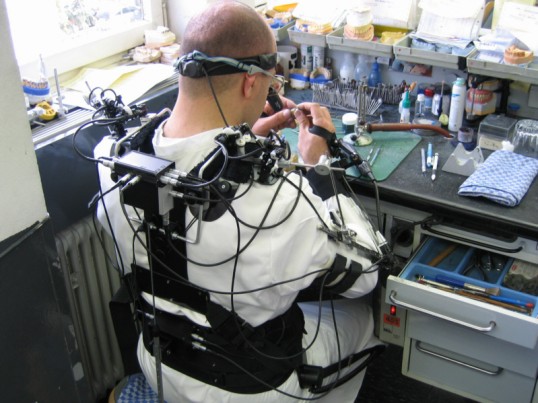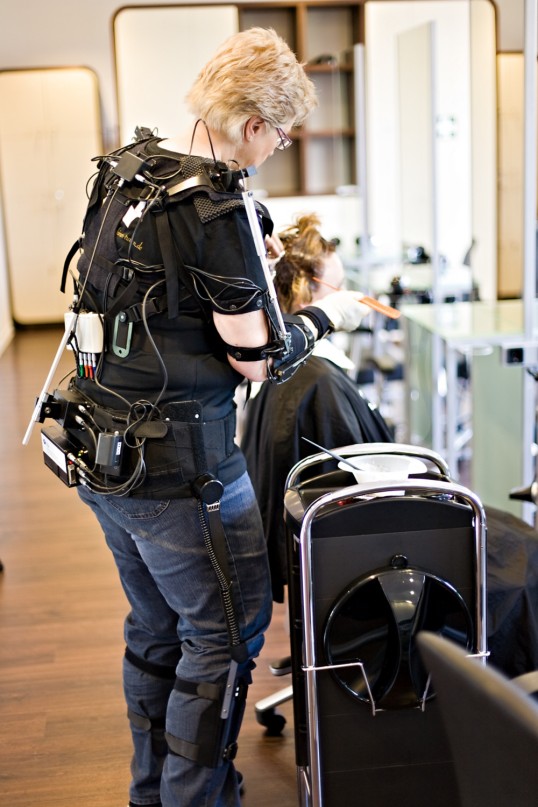- Artificial Intelligence (AI)
- Occupational exposure limit values
- Climate Change and Occupational Safety
- List of CMR substances
- Ergonomics
- EU GHS Regulation
- Industrial Security
- Collaborative robots
- Noise
- Nanoparticles at the workplace
- REACH
- Reference materials
- Proficiency testing
- Radiation
- Vibration
- Virtual reality
- Work 4.0
Occupational musculoskeletal diseases of the upper extremities

Dental technician using the CUELA measurement system during creation of a wax model for dentures
Source: IFA
An epidemiological relationship and therefore a relationship to the work can be established between the incidence of musculoskeletal diseases and complaints of the upper extremities on the one hand and repetitive tasks on the other. Owing to the widespread incidence of manual work processes in the world of work, workers in a range of occupational groups and tasks are affected. Occupational physicians and OSH professionals are increasingly confronted with issues of measurement and assessment of musculoskeletal workloads and with prevention of musculoskeletal diseases of the upper extremities. These professionals complain of an inadequate overview of validated findings and methods for exposure assessment. For this reason, the IFA has been conducting intensive work on occupational musculoskeletal diseases of the upper extremities since 1998 on behalf of the accident insurance institutions, and has been studying specific stresses arising from repetitive tasks.
The existing and proven CUELA measurement system is continually being developed further for this purpose. A version of CUELA was initially produced which is also able to record the movement processes of the arms and hands over longer periods during various forms of manual work and to make the data available for stress analysis by means of software, with the identification of characteristic values, see information sheet 0124 (PDF, 166 kB, non-accessible) .
Ongoing surveys led to findings being identified in the domestic and foreign literature. In order for repetitive tasks to be evaluated from the perspective of OSH-related prevention activity, these findings indicate that the following risk factors must be considered:
- Repetitiveness and duration of the repetitive tasks during a working shift
- Physical effort
- Body and joint movements and postures in unfavourable angle ranges
- Unfavourable factors of the working environment (vibration, cold, heat, etc.)
- Distribution of breaks and rest periods
In order for these factors to be recorded and incorporated into the overall assessment of the repetitive task, a number of observation methods are described. Worksheets are available for download containing brief descriptions of:
- RULA (rapid upper limb assessment)
- HAL TLVs (hand activity level threshold limit values)
- OCRA (occupational risk assessment of repetitive movements and exertions of the upper limb)
Comprehensive background information on the anatomy and physiology of the upper extremities, possible work-related risk factors and mechanisms of harm, and examples of practical application that illustrate the benefits and drawbacks of the assessment methods can be found in BGIA Report 2/2007.
Experience with metrological stress analysis gained in the field from workplace consulting activity and from research projects (see information sheets 0124 (PDF, 166 kB, non-accessible) and 0322 (PDF, 106 kB, non-accessible) , BGIA Report 7/2004 and projects IFA4189, IFA4171 and BGIA4128) supplements and deepens the findings of the theoretical scientific literature work, which are constantly being updated. This has led to further adaptations to the CUELA system in the form of modules for force measurement by means of grips and for assessment of the muscular strain, and with measured value-based force estimation by electromyography (EMG) with simultaneous recording of hand-arm postures and vibration. These modules deliver measurement parameters for quantification of the stated risk factors. The parameters are to be entered into a database from which task-specific stress profiles can be generated, ultimately leading to a validated risk assessment.
Publications

Muskel-Skelett-Erkrankungen der oberen Extremität. Entwicklung eines Systems zur Erfassung und arbeitswissenschaftlichen Bewertung von komplexen Bewegungen der oberen Extremität bei beruflichen Tätigkeiten (Musculoskeletal disorders of the upper extremities and occupational activities - Development of a system for the recording and ergonomic assessment of complex movements of the upper extremities in occupational activities)
BGIA-Report 2/2007 (in German)
Arbeitsbögen zur Bewertung von Arbeitsbezogenen Muskel-Skelett-Erkrankungen der oberen Extremität (AMSE-OE) und repetitive Tätigkeiten für die Verfahren:
- RULA (PDF, 240 kB, non-accessible) (Rapid Upper Limb Assessment),
- HAL TLVs (PDF, 52 kB, non-accessible) (Hand Activity Level Threshold Limit Values) and
- OCRA (PDF, 395 kB, non-accessible) (Occupational Risk Assessment of Repetitive Movements and Exertions of the Upper Limb).
Ergonomic requirements for computer input devices
BGIA-Report 3/2008e
Ergonomie an Näharbeitsplätzen (Ergonomics at sewing workplaces)
BIA-Report 7/2004 (in German) and
Focus on IFA's work No 0118 (PDF, 209 kB, non-accessible)
Measuring movement and posture in the shoulder-arm region
Focus on IFA's work No 0124 (PDF, 166 kB, non-accessible)
Contact
Ergonomics, Physical Environmental Factors
Tel: +49 30 13001-3451Fax: +49 30 13001-38001

